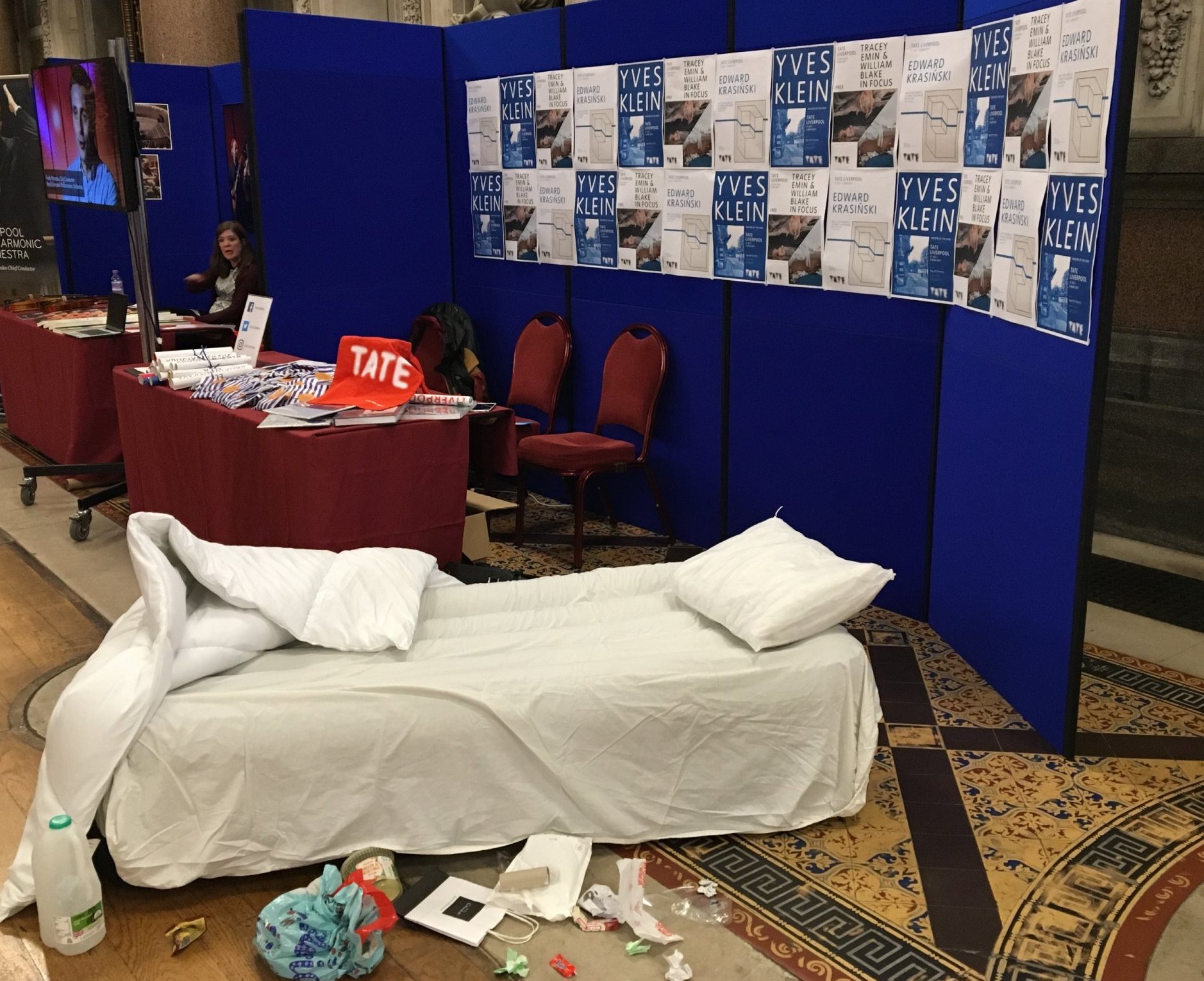
Tate Liverpool partcipate in a welcome event at Liverpool John Moores University
Meaningful learning partnerships
Tate Liverpool’s work with local universities enhances its education and audience development programmes. Michael Birchall reveals how it builds and maintains these partnerships.
Tate Liverpool opened almost 30 years ago in 1988 and from the beginning pioneered the idea of working with young people in a gallery setting. Since then our understanding and ethos around learning has evolved: we know it is crucial to make meaningful learning partnerships outside the gallery.
Over the years we have developed relationships with all the universities in the city: Liverpool John Moores University (LJMU), University of Liverpool, Liverpool Hope University and Edge Hill University, as well as further education institutions, including the City of Liverpool College. Further afield we work closely with Birmingham City University.
At first relationships can be quite transactional, but the longer you work together the more your trust and understanding develops
Recent examples of collaboration with higher education institutions include the Centre for Autonomous Systems Technology at the University of Liverpool working with artist Cécile B Evans to programme robots as part of a gallery installation called Sprung a Leak, and Edge Hill University sponsoring our current Yves Klein exhibition.
We also took part in a recent LJMU student welcome fair, an annual event that introduced the gallery as central to the city’s cultural experience. In the coming weeks a number of our university partners will take part in Tate Exchange Liverpool, a ground-breaking initiative that invites organisations to programme public activity.
Jointly funded role
An example of a deep, ongoing relationship is my jointly funded role as Curator of Public Practice at Tate Liverpool and Senior Lecturer in Exhibition Studies at LJMU. My role at the gallery is one that intersects between conventional exhibition forms and models of engagement that usually fall under the public programmes umbrella, including performances, talks and symposia.
At LJMU, I teach art theory and exhibition studies to undergraduates and postgraduates, and supervise PhD students. This is a joint post established in 2013 and I have been here since February of this year. The role was created to place academics within cultural institutions to maintain connections to artistic practice and to act as conduits for sharing ideas and understanding between academics, curators, artists and the public. LJMU has replicated this post across other cultural institutions in the city.
Shared benefits
For students at LJMU, the relevance and benefit to them is having a lecturer who is knowledgeable in the field of art theory and exhibition studies, but who also has a curatorial role in an institution. I am able to bring students into Tate Liverpool to draw on examples from real scenarios, and in some cases they have had the opportunity to co-create with us and directly contribute to the exhibition-making process.
Tate occupies a distinctive position within the academic landscape in the UK and internationally, and is transforming the way research is conducted, presented and disseminated. With an academic interest in socially engaged art, I am able to share knowledge with the curatorial team at Tate Liverpool and have delivered conference papers about models of engagement around co-production.
Thanks to my post, I am able to programme new activities for the gallery that make interdisciplinary links. For example, I recently invited LJMU’s Sian Lincoln, an expert in teenage bedroom culture, to take part in an in-conversation event focusing on Tracey Emin’s work My Bed 1998 (currently on display at Tate Liverpool). This offered an unexplored perspective away from art history and was certainly a popular event.
Next I am working on the co-curation of the gallery’s Spring 2017 community programme. Rather than a traditional exhibition, I will use my knowledge as a curator in the social sphere to work with an artist who will engage community groups across the north west, and deliver a public project over a six-week period.
As well as working across the long-term aims of our partnerships, Tate Liverpool offers partner university staff and students free access into special exhibitions and student discounts in the shop and café. Thinking both strategically and tactically has resulted in our college and university partnerships going from strength to strength.
The gallery is building the breadth of its student audience: 18% of visitors last year were 16 to 24 years old, a rise from 11% in 2014.
Long-term partnerships
To approach and maintain such partnerships I would first say that at the heart of all Tate Liverpool’s relationships is a shared ethos. Our city is filled with universities and colleges that value the importance of collaboration and understand they are part of a wider ecology in the city.
We approach all our partnerships with a view to be long term with a contractual memorandum of understanding and clear key performance indicators to deliver wider ambitions. In our experience, relationships take time to develop. At first relationships can be quite transactional, but the longer you work together the more your trust and understanding develops, and this is when longer-term thinking becomes possible.
On a practical level, universities and colleges are complex institutions, so establishing key contacts and pathfinders is incredibly helpful. Clear channels of communication allow the establishment of links across departments and not just those that are directly linked to the work an institution currently does.
As Tate Liverpool approaches its thirtieth birthday, we look to a future where we can further develop our relationships with universities and colleges, contributing not only to our own joint success but those of the city as a whole.
Michael Birchall is Public Practice Curator at Tate Liverpool and Senior Lecturer in Exhibition Studies at Liverpool John Moores University.
www.tate.org.uk/liverpool
Tw: @tateliverpool
Join the Discussion
You must be logged in to post a comment.